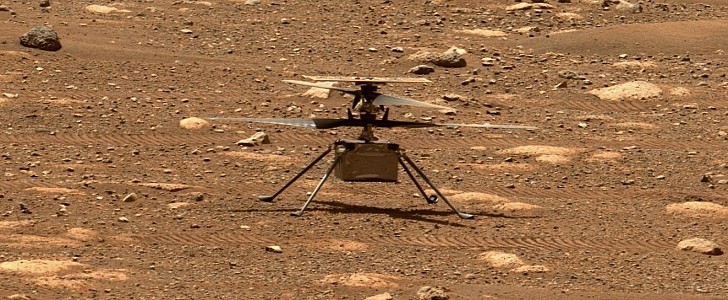Less than a year ago, NASA’s Ingenuity helicopter started to spin its blades in the thin atmosphere on Mars, demonstrating that flight was possible on another planet. The rotorcraft exceeded expectations, successfully completing more than 20 flights, but it also acted as an aerial scout for its robotic partner: the Perseverance rover.
Recently, Ingenuity powered through Flight 21. The small helicopter managed to stay in the air for more than two minutes, flying at a speed of 14 kph (8.6 mph) and covering a 370-meter (1,214-ft) distance. This flight is just the first one out of three that will take the rotorcraft across the Séítah region on Mars to its next destination: the ancient river delta.
NASA announced that it plans to extend Ingenuity’s flight operations through September at least. In the following months, the helicopter will support the Perseverance rover’s science campaign that focuses on investigating the ancient river delta of Jezero Crater.
The Jezero river delta campaign will be a challenging task for Ingenuity. Since it first touched down on Mars, the chopper has been exploring a relatively flat terrain. This won’t be the case with the delta, which is filled with jagged cliffs, irregular surfaces, boulders, and sand-filled pockets that could make landing very difficult.
“To enhance our chances of success, we have increased the size of our team and are making upgrades to our flight software geared toward improving operational flexibility and flight safety,” said Teddy Tzanetos, Ingenuity team lead at NASA’s Jet Propulsion Laboratory in Southern California.
With these upgrades, Ingenuity will be able to fly faster and cover larger areas. It will also be capable of recognizing changes in landscape texture while in flight. The navigation filter can be upgraded in the future to include terrain elevation maps, as well as a landing-hazard-avoidance feature.
But before starting its aerial scouting job of the delta, Ingenuity still has to cross the Séítah area. The rotorcraft is expected to take off once again on March 19th and travel another 350 meters (1,150 ft). The trip will be complex as it will involve averting a large hill in its path.
Once Ingenuity finally gets to the delta, it will help its rover buddy determine which path to follow. It will also provide data that will be used by the team behind Perseverance to establish the best spots that need to be investigated by the rover. Exploring the ancient delta-lake system is a crucial step in learning more about Mars’ wet past – Perseverance could even find the evidence that microscopic life once existed on the Red Planet.
NASA announced that it plans to extend Ingenuity’s flight operations through September at least. In the following months, the helicopter will support the Perseverance rover’s science campaign that focuses on investigating the ancient river delta of Jezero Crater.
The Jezero river delta campaign will be a challenging task for Ingenuity. Since it first touched down on Mars, the chopper has been exploring a relatively flat terrain. This won’t be the case with the delta, which is filled with jagged cliffs, irregular surfaces, boulders, and sand-filled pockets that could make landing very difficult.
“To enhance our chances of success, we have increased the size of our team and are making upgrades to our flight software geared toward improving operational flexibility and flight safety,” said Teddy Tzanetos, Ingenuity team lead at NASA’s Jet Propulsion Laboratory in Southern California.
With these upgrades, Ingenuity will be able to fly faster and cover larger areas. It will also be capable of recognizing changes in landscape texture while in flight. The navigation filter can be upgraded in the future to include terrain elevation maps, as well as a landing-hazard-avoidance feature.
But before starting its aerial scouting job of the delta, Ingenuity still has to cross the Séítah area. The rotorcraft is expected to take off once again on March 19th and travel another 350 meters (1,150 ft). The trip will be complex as it will involve averting a large hill in its path.
Once Ingenuity finally gets to the delta, it will help its rover buddy determine which path to follow. It will also provide data that will be used by the team behind Perseverance to establish the best spots that need to be investigated by the rover. Exploring the ancient delta-lake system is a crucial step in learning more about Mars’ wet past – Perseverance could even find the evidence that microscopic life once existed on the Red Planet.
Big news for the #MarsHelicopter: The rotorcraft is on its way to setting more records during its second year of operations. @NASA has extended Ingenuity’s flight operations through September as it continues with scouting efforts for @NASAPersevere. https://t.co/PkgFOYYo2C pic.twitter.com/nKXM9ryXey
— NASA JPL (@NASAJPL) March 15, 2022







